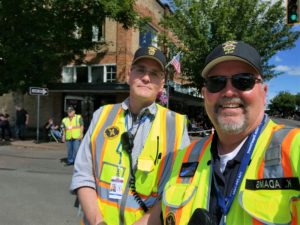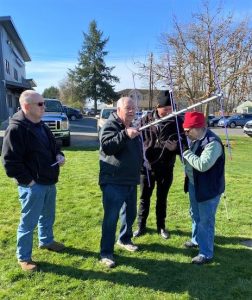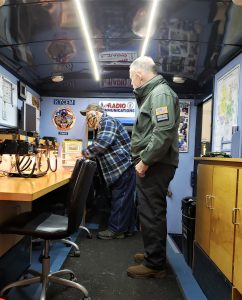
July 4th Downtown Centralia Parade




Yesterday was a beautiful late winter day with lots of sunshine and cool temperatures. Our Amateur Radio Emergency Service team meets twice a week at our local Fiddler’s Coffee Shop and the AO-91 communications satellite just happened to be passing overhead about the same time. With a daylight pass and a maximum elevation of 41 degrees, it turned out to be a great time for a demonstration. The pass was due to begin at 9:35am so everyone met about 15 minutes before so we could go over a few instructions, explain the equipment and establish who would be trying to make a contact. This is a joy when you have enough people to spread responsibilities around. One team member used his cell phone compass app to determine where AOS (acquisition of signal) would be. This is where the satellite would first appear over the horizon and to figure out where LOS (loss of signal) would line up as well. LOS is where the satellite disappears over the horizon. Another team member monitored the time so we would be ready for the 13 minute pass. Yet another member would use his cell phone recorder to create a record of the contacts. Finally, one person would hold the handheld radio and talk while the final person held the Arrow dual band antenna and followed the satellite. A metal building near the beginning of the pass would mean our total time for contacts would be down to about 7-8 total minutes but that would be enough.
With everyone ready, we could hear faint voices over the radio as AO-91 made its approach and Loyann (W7LOY) threw out her callsign and grid square. With a second call, she had a contact which was quickly followed by two more successful contacts. We quickly changed operators so others would have a chance and placed Kevin (KI7KKS) on the air. In a very short time, he also had a solid contact. Finally we were able to get Diane (W7DWD) on the air as the pass began to fade. She, too, was able to connect with another ham but we were not able to gather his information before AO-91 passed over the horizon. Satellite passes are fast, exciting and fun!
With the pass over, another 15 minutes were spent answering questions and rehashing what had just occurred. For most of the team, this was their very first satellite contact and it was exhilarating. Once the cold began to seep in, we decided we could discuss this event better inside with a great coffee. Everyone agreed we needed to do this again… and soon! You gotta love Ham Radio.

The Centralia ARES team maintains and operates two mobile communication vans. The vans are maintained, fueled, insured and repaired when needed, by the Centralia Police Department. Several years ago, the ARES team received the vans as empty shells and team members turned them into the best communication vans in the region by far.
January is the month we dedicate to making sure each and every team member not only knows how to safely drive the vans but, just as importantly, knows how to operate and use every radio and piece of equipment inside and outside as well. This includes light switches, power systems, VHF, UHF, HF, Police, Fire and even CB radios. Items used less often such as the helicopter landing zone kit, the backup antenna systems and even the anemometers are also important. Crime scene tape, equipment manuals, map books and field resource manuals, often tucked away, must be checked. Centralia ARES uses three different power sources to operate the vans in the field – shore power, generators and an on-board battery system – and every team member must know

how to operate these systems.
While the communication vans are easy to drive, we prepare our volunteers to respond to the fire department where the equipment is stored, and know how to enter the building, check and start the vans, raise the bay doors and safely transport the vans to where they are needed. Even when training or a real situation has concluded, the vans must be returned to the station and backed into their parking spaces safely and January is the month to perform this training.
Thankfully, both communication vans are almost identical and a couple of hours of refresher training is all that is needed. This training becomes vital in an emergency. In December, when activated for an evidence search after an ATM bombing at a local bank early on a Sunday morning, our Emergency Coordinator, while scrambling to initiate a deployment message, reached out to a team member and asked him to take the necessary equipment, including a communications van, to the scene. His only question was “what equipment do you need and where do you want it?”. Within minutes, he had one of our comm vans on scene and up and running. THAT is why we train.